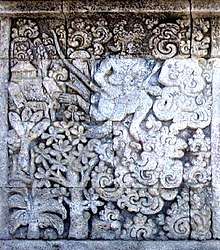Plumeria
Plumeria (/pluːˈmɛriə/) is a genus of flowering plants in the family Apocynaceae.[1] Most species are deciduous shrubs or small trees. The species variously are endemic to Mexico, Central America and the Caribbean, and as far south as Brazil and north as Florida, but are grown as cosmopolitan ornamentals in warm regions.[2][3] Common names for plants in the genus vary widely according to region, variety, and whim, but frangipani or variations on that theme are the most common. Plumeria is also used as a common name, especially in horticultural circles.[4]
| Plumeria | |
|---|---|
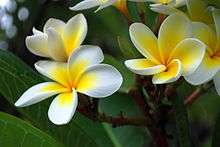 | |
| Plumeria sp. | |
| Scientific classification | |
| Kingdom: | Plantae |
| Clade: | Tracheophytes |
| Clade: | Angiosperms |
| Clade: | Eudicots |
| Clade: | Asterids |
| Order: | Gentianales |
| Family: | Apocynaceae |
| Subtribe: | Plumeriinae |
| Genus: | Plumeria L.[1] |
| Species | |
|
See text | |
| Synonyms[2] | |
| |
Description
Plumeria flowers are most fragrant at night in order to lure sphinx moths to pollinate them. The flowers yield no nectar, however, and simply trick their pollinators. The moths inadvertently pollinate them by transferring pollen from flower to flower in their fruitless search for nectar.[5] Insects or human pollination can help create new varieties of plumeria. Plumeria trees from cross pollinated seeds may show characteristics of the mother tree or their flowers might just have a totally new look.
Plumeria species may be propagated easily by cutting leafless stem tips in spring. Cuttings are allowed to dry at the base before planting in well-drained soil. Cuttings are particularly susceptible to rot in moist soil. One optional method to root cuttings is applying rooting hormone to the clean fresh-cut end to enable callusing. Plumeria cuttings could also be propagated by grafting a cutting to an already rooted system.[6] The Plumeria Society of America lists 368 registered cultivars of Plumeria as of 2009.[7]
Etymology and common names
The genus is named in honor of the seventeenth-century French botanist and Catholic monk Charles Plumier, who traveled to the New World documenting many plant and animal species.[8] The common name "frangipani" comes from a sixteenth-century marquis of the noble family in Italy who claimed to invent a plumeria-scented perfume,[9] but in reality made a synthetic perfume that was said at the time to resemble the odor of the recently discovered flowers.[10] Many English speakers also simply use the generic name "plumeria".
In South East Asia this tree and its flower is considered sacred. A relief in Penataran temple in East Java shows a plumeria tree with its distinct flower-petals and skeleton-like branches.[11] Another relief in Borobudur, at the west side, 1st zone also depict plumeria.[12] These reliefs, which were created before European exploration (Brobudur constructed in ~ 9th CE and Penataran in ~ 14 CE) makes a difficult question about when plumeria came to South East Asia.
In eastern India and Bangladesh,it is traditionally considered as a variety of champak flower, the golok chapa (গোলোক চাঁপা), meaning the champaka that resides the heavenly home of Sree Krishna, a hindu god residing at the highest realm of heaven. This flower is considered sacred and also adorned by the name of gulancha and kath golap (literally, wood rose)!
In culture
In Mesoamerica, plumerias have carried complex symbolic significance for over two millennia, with striking examples from the Maya and Aztec periods into the present. Among the Maya, plumerias have been associated with deities representing life and fertility, and the flowers also became strongly connected with female sexuality. Nahuatl-speaking people during the height of the Aztec Empire used plumerias to signify elite status, and planted plumeria trees in the gardens of nobles.[13]
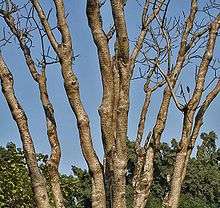
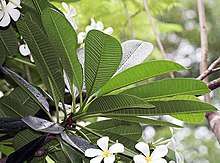
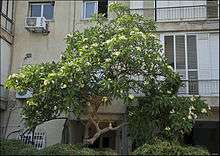
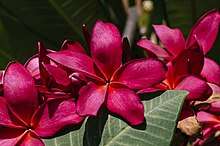
These are now common naturalized plants in southern and southeastern Asia. In local folk beliefs they provide shelter to ghosts and demons. They are also associated with temples in both Hindu, Jain, and Buddhist cultures.
In several Pacific islands, such as Tahiti, Fiji, Samoa, Hawaii, New Zealand, Tonga, and the Cook Islands plumeria species are used for making leis.[14] In modern Polynesian culture, the flower can be worn by women to indicate their relationship status—over the right ear if seeking a relationship, and over the left if taken.[15]
Plumeria rubra is the national flower of Nicaragua, where it is known under the local name "sacuanjoche".
Plumeria alba is the national flower of Laos, where it is known under the local name champa or "dok champa".
In Bengali culture, most white flowers, and in particular, plumeria (Bengali, চম্পা chômpa or চাঁপা chãpa), are associated with funerals and death.
Also in the Philippines, Indonesia and Malaysia, the plumeria is often associated with ghosts and cemeteries.[16] Plumerias often are planted on burial grounds in all three nations. They are also common ornamental plants in houses, parks, parking lots and other open-air establishments in the Philippines. Balinese Hindus use the flowers in their temple offerings. The plumeria's fragrance is also associated with the kuntilanak, an evil vampiric spirit of a dead mother in Malaysian-Indonesian folklores.
Indian incenses fragranced with Plumeria rubra have "champa" in their names. For example, Nag Champa is an incense containing a fragrance combining plumeria and sandalwood. While plumeria is an ingredient in Indian champa incense, the extent of its use varies between family recipes. Most champa incenses also incorporate other tree resins, such as Halmaddi (Ailanthus triphysa) and benzoin resin, as well as other floral ingredients, including champaca (Magnolia champaca), geranium (Pelargonium graveolens), and vanilla (Vanilla planifolia) to produce a more intense, plumeria-like aroma.[17]
In the Western Ghats of Karnataka, the bride and groom exchange garlands of cream-coloured plumeria during weddings. Red colored flowers are not used in weddings. Plumeria plants are found in most of the temples in these regions.
In Sri Lankan tradition, plumeria is associated with worship. One of the heavenly damsels in the frescoes of the fifth-century rock fortress Sigiriya holds a 5-petalled flower in her right hand that is indistinguishable from plumeria.[18]
In Eastern Africa, frangipani are sometimes referred to in Swahili love poems.[19]
Some species of plumeria have been studied for their potential medicinal value.[20]
There are a few more new hybrids now (Nui Delight, Nui's Diamond Rose, Nui's Dragon Heart, Nui's Light of Hope), named after Nui Leera from Thailand, who has planted over 100,000 plumeria seeds (2018).
Taxonomy
The genus Plumeria includes about a dozen accepted species, and one or two dozen open to review, with over a hundred regarded as synonyms.[21]
Plumeria species have a milky latex that, like many other Apocynaceae contains poisonous compounds that irritate the eyes and skin.[22] The various species differ in their leaf shape and arrangement. The leaves of Plumeria alba are narrow and corrugated, whereas leaves of Plumeria pudica have an elongated shape and glossy, dark-green color. Plumeria pudica is one of the everblooming types with non-deciduous, evergreen leaves. Another species that retains leaves and flowers in winter is Plumeria obtusa; though its common name is "Singapore," it is originally from Colombia.
Species
Plants of the World Online[23] lists the following:
- Plumeria alba L. - Puerto Rico, Lesser Antilles
- Plumeria clusioides Griseb.
- Plumeria cubensis Urb.
- Plumeria ekmanii Urb.
- Plumeria emarginata Griseb.
- Plumeria filifolia Griseb. - Cuba
- Plumeria inodora Jacq. - Guyana, Colombia, Venezuela (incl Venezuelan islands in Caribbean)
- Plumeria krugii Puerto Rico
- Plumeria lanata Britton
- Plumeria magna Zanoni & M.M.Mejía - Dominican Republic
- Plumeria montana Britton & P.Wilson
- Plumeria obtusa L. - West Indies including Bahamas; southern Mexico, Belize, Guatemala, Florida; naturalized in China
- Plumeria pudica Jacq. - Panama, Colombia, Venezuela (incl Venezuelan islands in Caribbean)
- Plumeria rubra L. - Mexico, Central America, Venezuela; naturalized in China, the Himalayas, West Indies, South America, and numerous oceanic islands
- Plumeria sericifolia C.Wright ex Griseb.
- Plumeria × stenophylla Urb. - Mexico and Central America
- Plumeria subsessilis A.DC. - Hispaniola
- Plumeria trinitensis Britton
- Plumeria tuberculata G.Lodd.
- Plumeria venosa Britton
Synonyms
- The following may be designated to the nominate subspecies of Plumeria obtusa L.:
- The following may be considered synonyms of Plumeria obtusa var. sericifolia (C.Wright ex Griseb.) Woodson:
- Formerly included in genus[2]
- Plumeria ambigua Müll.Arg. = Himatanthus bracteatus (A.DC.) Woodson
- Plumeria angustiflora Spruce ex Müll.Arg. = Himatanthus attenuatus (Benth.) Woodson
- Plumeria articulata Vahl = Himatanthus articulatus (Vahl) Woodson
- Plumeria attenuata Benth = Himatanthus attenuatus (Benth.) Woodson
- Plumeria bracteata A.DC. = Himatanthus bracteatus (A.DC.) Woodson
- Plumeria drastica Mart. = Himatanthus drasticus (Mart.) Plumel
- Plumeria fallax Müll.Arg. = Himatanthus drasticus (Mart.) Plumel
- Plumeria floribunda var floribunda = Himatanthus articulatus (Vahl) Woodson
- Plumeria floribunda var. acutifolia Müll.Arg. = Himatanthus bracteatus (A.DC.) Woodson
- Plumeria floribunda var. calycina Müll.Arg. = Himatanthus bracteatus (A.DC.) Woodson
- Plumeria floribunda var. crassipes Müll.Arg. = Himatanthus bracteatus (A.DC.) Woodson
- Plumeria hilariana Müll.Arg. = Himatanthus obovatus (Müll.Arg.) Woodson
- Plumeria lancifolia Müll.Arg. = Himatanthus bracteatus (A.DC.) Woodson
- Plumeria latifolia Pilg. = Himatanthus obovatus (Müll.Arg.) Woodson
- Plumeria martii Müll.Arg. = Himatanthus bracteatus (A.DC.) Woodson
- Plumeria microcalyx Standl. = Himatanthus articulatus (Vahl) Woodson
- Plumeria mulongo Benth. = Himatanthus attenuatus (Benth.) Woodson
- Plumeria obovata Müll.Arg. = Himatanthus obovatus (Müll.Arg.) Woodson
- Plumeria oligoneura Malme = Himatanthus obovatus (Müll.Arg.) Woodson
- Plumeria phagedaenica Benth. ex Müll.Arg. 1860 not Mart. 1831 = Himatanthus drasticus (Mart.) Plumel
- Plumeria phagedaenica Mart. 1831 not Benth. ex Müll.Arg. 1860= Himatanthus phagedaenicus (Mart.) Woodson
- Plumeria puberula Müll.Arg. = Himatanthus obovatus (Müll.Arg.) Woodson
- Plumeria retusa Lam. = Tabernaemontana retusa (Lam.) Pichon
- Plumeria revoluta Huber = Himatanthus stenophyllus Plumel
- Plumeria speciosa Müll.Arg. = Himatanthus bracteatus (A.DC.) Woodson
- Plumeria sucuuba Spruce ex Müll.Arg. = Himatanthus articulatus (Vahl) Woodson
- Plumeria tarapotensis K.Schum. ex Markgr. = Himatanthus tarapotensis (K.Schum. ex Markgr.) Plumel
- Plumeria velutina Müll.Arg. = Himatanthus obovatus (Müll.Arg.) Woodson
- Plumeria warmingii Müll.Arg. = Himatanthus obovatus (Müll.Arg.) Woodson
Gallery
- Red frangipani found in Malaysia.
- Red frangipani found in Malaysia.
.jpg) Plumeria in the Jardin des Plantes de Lille, Lille, France.
Plumeria in the Jardin des Plantes de Lille, Lille, France. Pink frangipani
Pink frangipani White Plumeria, found at Andhra Pradesh
White Plumeria, found at Andhra Pradesh
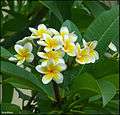

References
- "Genus: Champa L." Germplasm Resources Information Network. United States Department of Agriculture. 2003-03-14. Retrieved 2010-09-08.
- "World Checklist of Selected Plant Families". Retrieved May 18, 2014.
- Urs Eggli, ed. (2002). Illustrated Handbook on Succulent Plants. 5: Dicotyledons. Springer. p. 16. ISBN 978-3-540-41966-2.
- M.M. Grandtner (8 April 2005). Elsevier's Dictionary of Trees: Volume 1: North America. Elsevier. pp. 679–. ISBN 978-0-08-046018-5.
- Haber, William A. (1984). "Pollination by Deceit in a Mass-Flowering Tropical Tree Plumeria rubra L. (Apocynaceae)". Biotropica. 16 (4): 269–275. doi:10.2307/2387935. JSTOR 2387935.
- Thornton, Sharon H. (1985). The Exotic Plumeria (Frangipani). Plumeria Specialties. p. 21.
- "Registered Plumeria". The Plumeria Society of America. Retrieved 2019-03-02.
- "Zumbroich, Thomas J. 2013. 'Plumerias the Color of Roseate Spoonbills'- Continuity and Transition in the Symbolism of Plumeria L. in Mesoamerica. Ethnobotany Research & Applications 11:341-363". Retrieved 2015-04-15.
- George William Septimus Piesse (1867). The Art of Perfumery and the Methods of Obtaining the Odors of Plants: With Instructions for the Manufacture of Perfumes for the Handkerchief, Scented Powders, Odorous Vinegars, Dentifrices, Pomatums, Cosmetics, Perfumed Soap, Etc., to which is Added an Appendix on Preparing Artificial Fruit-essences, Etc. Lindsay & Blakiston. p. 23. Retrieved 2017-07-08.CS1 maint: date and year (link)
- Andrew Kettler (2015). "Making the Synthetic Epic". The Senses and Society. 10: 5–25. doi:10.2752/174589315X14161614601682.
- Beragam Tanaman Pada Relief Candi di Jawa Timur Abad 14 Masehi; Skripsi_Regina Yofani_UI 2010
- http://borobudurvirtual.id/borobudurpedia/encyclopedia/kamboja/
- "Zumbroich, Thomas J. 2013. 'Plumerias the Color of Roseate Spoonbills'- Continuity and Transition in the Symbolism of Plumeria L. in Mesoamerica. Ethnobotany Research & Applications 11:341-363". Retrieved 2015-03-10.
- Jones, Jay (April 22, 2008). "Hawaii keeps the lei-making tradition alive". Los Angeles Times.
- "Symbolism of Wearing Hawaiian Flowers". Retrieved 2015-12-20.
- Bautista, Norby (April 22, 2015). "The summer blooming of the Kalachuchi". Manila Bulletin. Retrieved December 19, 2015.
- "Equinox Aromatics, LLC - Halmaddi - Ailanthus triphysa - India". Archived from the original on 9 July 2014. Retrieved 18 August 2015.
- "Kottegoda, S R, Flowers of Sri Lanka, Colombo, Royal Asiatic Society of Sri Lanka, 1994; pp xiii-xiv". Archived from the original on 2011-08-09. Retrieved 2010-09-07.
- Knappert, Jan (1972) An Anthology of Swahili Love Poetry, University of California Press, page 93. ISBN 0-520-02177-0
- Sharma, Garima; Chahar, Maheep K.; Dobhal, Sonal; Sharma, Neelu; Sharma, Tek Chand; Sharma, Mahesh C.; Joshi, Yogesh C.; Dobhal, Mahabeer P. (2011). "Phytochemical Constituents, Traditional Uses, and Pharmacological Properties of the Genus Plumeria". Chemistry. 8 (8): 1357–1369. doi:10.1002/cbdv.201000159.
- The Plant List (2013). Version 1.1. Published on the Internet; http://www.theplantlist.org/ (accessed December 2016)
- College of Tropical Agriculture and Human Resources (CTAHR). Ornamentals and Flowers. Feb. 1998. OF-24.
- Plants of the World Online Plumeria Tourn. ex L. (retrieved 6 May 2019)
- http://www.theplantlist.org/tpl1.1/record/kew-161613 The Plant List (RBG, Kew, MBG) access date: 2015-02-26
- http://www.theplantlist.org/tpl1.1/record/kew-161615 The Plant List (RBG, Kew, MBG) access date: 2015-02-26
External links
| Wikimedia Commons has media related to Plumeria. |
| Wikispecies has information related to Plumeria |
